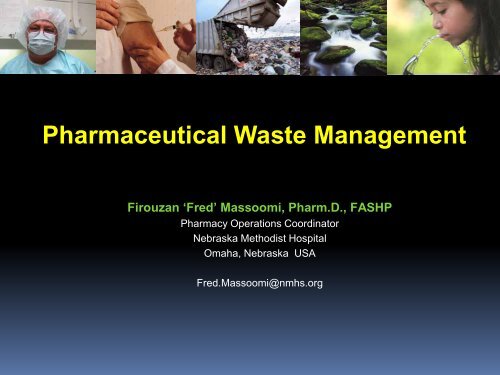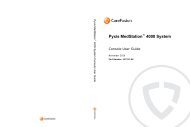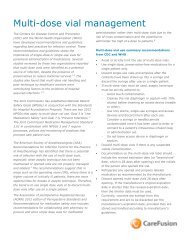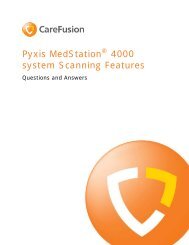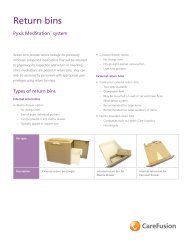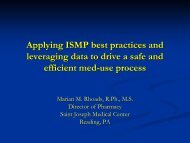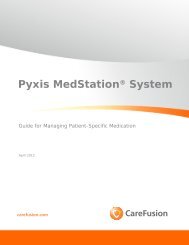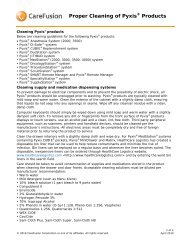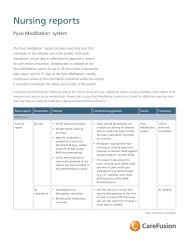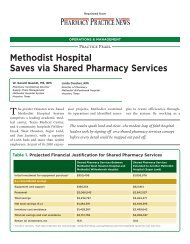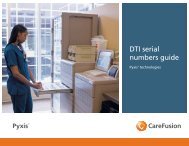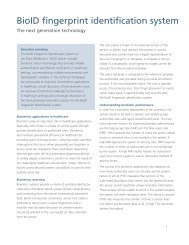Pharmaceutical Waste Management - The Pyxis ® Insider newsletter
Pharmaceutical Waste Management - The Pyxis ® Insider newsletter
Pharmaceutical Waste Management - The Pyxis ® Insider newsletter
- No tags were found...
You also want an ePaper? Increase the reach of your titles
YUMPU automatically turns print PDFs into web optimized ePapers that Google loves.
<strong>Pharmaceutical</strong> <strong>Waste</strong> <strong>Management</strong>Firouzan ‘Fred’ Massoomi, Pharm.D., FASHPPharmacy Operations CoordinatorNebraska Methodist HospitalOmaha, Nebraska USAFred.Massoomi@nmhs.org
<strong>The</strong> <strong>Pharmaceutical</strong>-Water Paradigm• Defined by WHO as an emerging contaminantfor drinking-water• Defined by US EPA as an emerging contaminantaffecting human an ecological health• 100,000 tons of drugs consumed annually• 70% increase in drug consumption 1993-2003• Finite source of Clean waterSources: WHO; KNAPPE; IMS 2011
• March & September 2008œ Health facilities flush 250 million pounds of drugs a year• DEA implicated as major hurdle for proper disposal• March 03, 2011œ Integrity of the world water supply “From toilets to tap”œ 10% of household water comes from toiletsSource: USA Today
Large Geographical Survey• US Geological surveyœ 1999 -2000• 139 streams, waterwaysœ 80% contaminated• Primary contaminantsœ Antibioticsœ Anti-convulsantsœ Mood stabilizersœ Cholesterol lowering agentsœ Analgesicsœ Reproductive hormones
Environmental Effects• Steroid plant discharge andintersex wild gudgeonsœ France• Ethinyl estradiol feminizationof male fishœ Canada, US, EU• New gene splicingidentificationœ medaka fish + jelly fish gene• Dicofenac vulture deathsœ Pakistan, IndiaSource: New Scientist 2011Source: Nature 2011
Which Pharmacy Class Did We Learn This In?
US Regulatory Bodies for RX <strong>Waste</strong>sPublic SafetyPublic SafetyPublic SafetyPublic Safety• US Environmental Protection Agencyœ 1976 Resource Conservation Act (RCRA)œ Federal & State Specific Regulations• Local Publicly Owned Treatment Works (POTWs)œ Permission has to be granted to dump/pourœ Local Regulations• Occupational Safety and Health Agencyœ Hazard Communication Standard 29 CFR part 1910–1200œ Hazardous <strong>Waste</strong> Operations and Emergency ResponseStandard (29 CFR 1910.120)• Drug Enforcement Agencyœ Controlled Substances Act of 1984œ NO SPECIFIC guidance on destruction only accountability
Regulatory Bodies for RX <strong>Waste</strong>sPublic SafetyPublic Safety• Department of Transportationœ HAZWOPER from OSHAœ Hazardous <strong>Waste</strong> Transportation regulations• Food and Drug Administrationœ 27 drugs with package insert disposal recommendationsœ Assisted White House policy for public disposalExamination Bodies for RX <strong>Waste</strong>s
Pending Legislation• Drug Free Water Act of 2009œEPA Task Force regarding proper disposal of unused drugs• Safe Drug Disposal Act of 2009œœAmend Controlled Substances Act to provide for the disposal ofcontrolled substances by ultimate users and care takers throughState take-back disposal programsTo amend the Federal Food, Drug and Cosmetic Act to prohibitrecommendations on drug labels for the disposal by flushing• Secure & Responsible Drug Disposal Act of 2009 – PASSEDœ To amend the Controlled Substances Act to enable consumertake-back programsœ STATES MUST APPROVE FIRST!Slide courtesy of Charlotte Smith
How did the EPA get involved?• Creation of EPA 1970œ Prior to loose standards ondisposal regulationsœ Lack of environmental protectionCuyahoga River, OHFire History1949, 1951, 1952x3,1961, 1969• EPA's mission is to protect humanhealth and to safeguard the naturalenvironment— air, water, and land—upon which life depends
What Drug <strong>Waste</strong> is Regulated?• Solid <strong>Waste</strong> Disposal Act of 1965œ “encourage environmentally sound methods for disposalof household, municipal, commercial, and industrialrefuse”œ 1976 Resource Conservation and Recovery Act (RCRA)• Clean Air Act 1991œ Regulated-out hospital based incineratorsHooker Chemical company-dumped 20,000 tons-contaminated water and soil$400mil to clean-upWhat was the real cost?
US EPA Guidance to Healthcare• Healthcare onlyœHospitals, long term care,clinics• Estimated 12 millionpounds• No guidance on disposal• Projected best practicedocument in 2012Source: US EPA 2008
P-listedDrug, vials and packagingEPA Defined Hazardous DrugsU-listedDrug onlyP012Arsenic TrioxideU034Chloral HydrateU010Mitomycin CP042P075P081P204P188EpinephrineNicotineNitroglycerinPhysostigminePhysostigmine salisylateU035 ChlorambucilU044 CloroformU058 CyclophosphamideU059 DaunomycinU075 DichlorodifluromethaneU089 DiethylstilbestrolU182U188U200U201U202U205ParaldehydePhenolReserpineResorcinolSaccharineSeleniumP046PhentermineU122FormaldehydeU206StreptozocinP001 Warfarin >0.3%U129LindaneU237Uracil MustardU150U151MelphalanMercuryU248 Warfarin
Exemptions are State Specific• EPA guidance on exemptions• Nitroglycerin Federal Register: May 16, 2001 (Volume 66, Number 95)• Epinephrine Salts USEPA Memo Dated 10/07/2007• States who do NOT allow exemptionsNitroglycerinEpinephrine saltsConnecticutConnecticutHawaiiHawaiiMaine New York – exempted 7/15/09MichiganWashington*Florida, Michigan, Minnesota, Washington
EPA Defined Hazardous DrugsD-Listed Characteristic Chemical <strong>Waste</strong>•Ignitability (D001)•Corrosivity (D002)•Reactivity (D003)•ToxicityNOTE: primary drug may not be what is listed!D004 Arsenic 5 mg/L DualD005 Barium 100 mg/L OralD007 Chromium 5 mg/L TPND024 M-Cresol 200 mg/L InsulinD013 Lindane 0.4 mg/LD009 Mercury 0.2 mg/L VaccineD101 Selenium 1 mg/L TPND011 Silver 5 mg/L CreamsSource: www.access.gpo.gov/nara/cfr/cfrhtml_00/Title_40/40cfr261_00.html
Current Practice Drug <strong>Waste</strong> ProcessExpired drugsReverse DistributorSpecial Drug <strong>Waste</strong>: Devices/GasesBiohazardous wasteAutoclauveEmpty IV Bags/Drug PackagingHospitalNon-‘hazardous’ <strong>Waste</strong>sControlled Substances?Chemotherapy ‘hazardous’ <strong>Waste</strong>sMedical <strong>Waste</strong>IncineratorRCRA Segregated ‘hazardous’ <strong>Waste</strong>sIV & Irrigation Solutions: NO DrugsRCRA IncineratorMassoomi 2011©Water Treatment Plant
Risk <strong>Management</strong> & Liability• Civil and criminal liabilityœ Civil & Criminal: State/USEPA enforcement• Personal liabilityœ fines and/or imprisonment• Corporate finesœ $37,500 per violation/day• Eastern Kansas Health Care System August 18, 2009œ What $51,501 civil penalty & $482,069 supplemental projectœ Violations No hazardous waste determinations No proper hazardous waste containers No documentation of inspection of hazardous waste storage No documentation of personnel training Unpermitted on-site incineration of hazardous waste Unlawful shipping of hazardous waste
Healthcare RCRA ViolationsBreakout of RCRA Violations from Hospital DisclosuresContainer<strong>Management</strong> 21%UST 2%GeneratorRequirements 12%ID of HW 23%General FacilityStandards 16%Accumulation Time2% Manifest 6%Universal <strong>Waste</strong>18%Slide courtesy of John Gorman, USEPA Region 2
DOT Manifest for TransportStandard US form• Page 1œ Main form (left)• Page 2œ “Designated Facility toGenerator State• Page 3œ “Designated Facility toGenerator Copy”• Page 4œ “Designated Facility Copy”• Page 5œ “Transporter" copy• Page 6œ “Generator’s Initial Copy”http://www.pneac.org/hazwastemanifest/manifest_video/manifest.html
N=343 Rx Directors
EPA’s Current StatusNo Health-system surveyGuidance Document: Best <strong>Management</strong>Practices for Unused <strong>Pharmaceutical</strong>At Health Care Facilities• Modeled off of H2E publication?• Draft; Aug 26, 2010• Publication 2012?• Universal <strong>Waste</strong> Rule proposal updateœ Not to be..Source: Meghan Hessenauer, US EPA Office of Water, Nov ,2011
<strong>Pharmaceutical</strong> <strong>Waste</strong> Team• PrimaryœœœœœœHospital administrationPharmacy LeadNursing LeadRisk <strong>Management</strong>Environmental ServicesPhysicists• SecondaryœœœœœInfection ControlSafety OfficerFacility <strong>Management</strong>Purchasing leads• <strong>Pharmaceutical</strong>s• Surgical supplies• Central suppliesPhysician office managers
Think of All Areas WhereDrugs Are Handled310 Patient Rooms52 <strong>Pyxis</strong> Stations28 Med refrigerators26 Surgical suites15 Infusion chairs12 Hospital clinics5 MRI suites7 CT suites2 Anesthesia rooms2 Pharmacies459 Total Locations
Non-hazardous Pharmacy <strong>Waste</strong>œœSeweredPlain IV fluidsPlain IrrigationsœœLandfillPackaging (Non-P listed)Empty vialsMedical Hazardous <strong>Waste</strong> IncinerationRCRA Hazardous Incineration(<strong>Waste</strong> to Energy)
Biohazard Sharps Containers• “Unused pharmaceuticalsshould not be disposed of withbiohazardous waste”œ Autoclavingœ Heat to 180º F• If used send to a medicalwaste incineratorœ Heat to 500º to 900º FDraft: Guidance Document: Best <strong>Management</strong> Practices for Unused <strong>Pharmaceutical</strong>At Health Care Facilities: EPA-821-R-10-006; Aug 26, 2010
Controlled Substance <strong>Waste</strong>Mandatory ACCOUNTABILITY !• No definition of “waste”• No distinction between expired, contaminatedcontrolled substances and saleable product• Accountability required of all controlled substances• Most US hospitals Sewer this waste• Reverse Distributors› to be DEA Registrants to removeSource: Mark W. Caverly, Chief; DEA Office of Diversion Control
Aerosolized Drug Products• Highly specialized drug delivery devicesœ Varying international regulations• Puncture PRIOR to incineration• Triple rinsing prior to landfill• Rinsate disposed of properly
Anesthesia Gases• Anesthetic gases are green house gases• 5% of gases used by patient• Global Warming Potentials• Nitrous Oxide: 289x• Desflurane: 3714x• Isoflurane: 1401x• Sevoflurane: 349x• Gases liquefied and purifiedœ FUTURE: resale of productsSource: Laura Brannen, BLUE
Medicinal Leeches and MaggotsBiohazardous <strong>Waste</strong>
Formulary Assessment of <strong>Waste</strong>• Collaborative formulary assessmentœ NIOSH Appendix A & IARCœ State and Federal regulationsœ <strong>Waste</strong> hauler processDRUG - GENERIC(BRAND)CLASS OFMEDICATIONROUTES/FORMSCOMPANYPREGNANCYCATEGORY MSDS BSCHAZCLASS(1-4)WASTESTREAMAldesleukin(Proleukin) ONC INJ Chrion C YES Yes Class 1 YELLOW NAlemtuzumab(Campth) ONC INJ Berlex C YES Yes Class 1 YELLOW NAlitretinoin(Panretin)Altretamine(Hexalen)RetinoidONCTOPICAL,GEL Ligand D YESORAL,CAPSULE MGI D YESYes, ifaltered Class 1 YELLOW NYes, ifaltered Class 1 YELLOW NRCRA Y/NœContinuous assessment of Risk and Stream
N=343 Rx Directors
Model IManual Sorting of Regulated <strong>Waste</strong>• Entire inventory has been manually analyzedœ New drugs have to added to the system• Items are labeledœ During receiving process or electronically• Regulated drugs are dispensing in colored bagUsed with permission: Leslie Durrant, R.Ph., BCPS
Model IIElectronic Devices for RX <strong>Waste</strong>EcoREXSmart Sink• Automatic Sorting System• Barcode segregation• Alerts staff when full• Completes DOT manifestswww.carefusion.com• Solid and liquid wastes• Renders unusable unrecoverable• Tamper evident, notification• Wall mount, COW mount• ONLY for collection of all wasteswww.cactusllc.net
Model IIICentralizing Segregation• All pharmaceutical waste is collected in hazardous waste containers• Mixed waste is removed to the central hazardous waste storageaccumulation area• Sorting is done by hazardous waste vendor or trained hospital staff basedon an analysis of the inventory• NOTE: the generator (HOSPITAL) is liable for contracted employee harmSource: Charlotte A. Smith, R. Ph., M.S.,
Model IVManaging All RX <strong>Waste</strong> as Hazardous• One Container for collection• Easiest• Need to sort out characteristicwastesœ Toxic, Corrosive, Ignitable, Reactive• Storage space issues
Current Practice Drug <strong>Waste</strong> ProcessExpired drugsReverse DistributorSpecial Drug <strong>Waste</strong>: Devices/GasesBiohazardous wasteAutoclauveEmpty IV Bags/Drug PackagingHospitalNon-‘hazardous’ <strong>Waste</strong>sControlled Substances?Chemotherapy ‘hazardous’ <strong>Waste</strong>sMedical <strong>Waste</strong>IncineratorRCRA Segregated ‘hazardous’ <strong>Waste</strong>sIV & Irrigation Solutions: NO DrugsRCRA IncineratorMassoomi 2011©Water Treatment Plant
Proper Hazardous Drug <strong>Waste</strong> DisposalPoster ExampleSegregate the wastes of Drugs & Dispose of in appropriate containersSHARPSRed ContainerBIOHAZARDOUSRed ContainerHazardousYellow ContainerRCRA HAZARDOUSBlack ContainerNon-Regulated TrashSharps BioHaz CHEMO RCRA Trash-Needles-Broken Glass-Ampules-Other sharps-Non-Chemo vials-IVIG vials/bags-Albumin vials/bags-Blood factor vials-Syringes-IV Bags and Tubing-Empty Chemo vials-Chemo packaging< boxes, PIs>-Chemo mats not involvedwith spills-Chemo Gloves-PhaSeal devicesALL partial Chemo Dose vialsDrugs on EPA P & U list1.Chlorambucil2.Cyclophosphamide3.Daunomycin4.Melphalan5.Mitomycin C6.Streptozotocin7.Arsenic Trioxide8.Idarubicin9.Carmustin including Gliadel10.Uracil mustard11.Anything used 4 chemo spillEverythi ng El se N O Tcontaminated1.Packaging2.IV wraps3.Syringe packaging4.PhaSeal packaging5.Gauzes6.Gowns7.Masks8.Paper9.Labels, etc.Contact Service Center for questions: XXX-XXX-XXXX
Assessment of ComplianceTrash RoundsStaff ProcessesCheck StreamsRandom audits for compliance1. Check staff knowledge2. Check waste containers3. Track quantities4. Track costs5. Document process and results
N=343 Rx Directors
Future <strong>Waste</strong> Considerations• Disposable drug delivery device wastes• Genotargeted drug wastes• Drug loaded Adenovirus wastes• Nanotechnology drug wastes
<strong>Pharmaceutical</strong> <strong>Waste</strong> <strong>Management</strong>Firouzan ‘Fred’ Massoomi, Pharm.D., FASHPPharmacy Operations CoordinatorNebraska Methodist HospitalOmaha, Nebraska USAFred.Massoomi@nmhs.org


